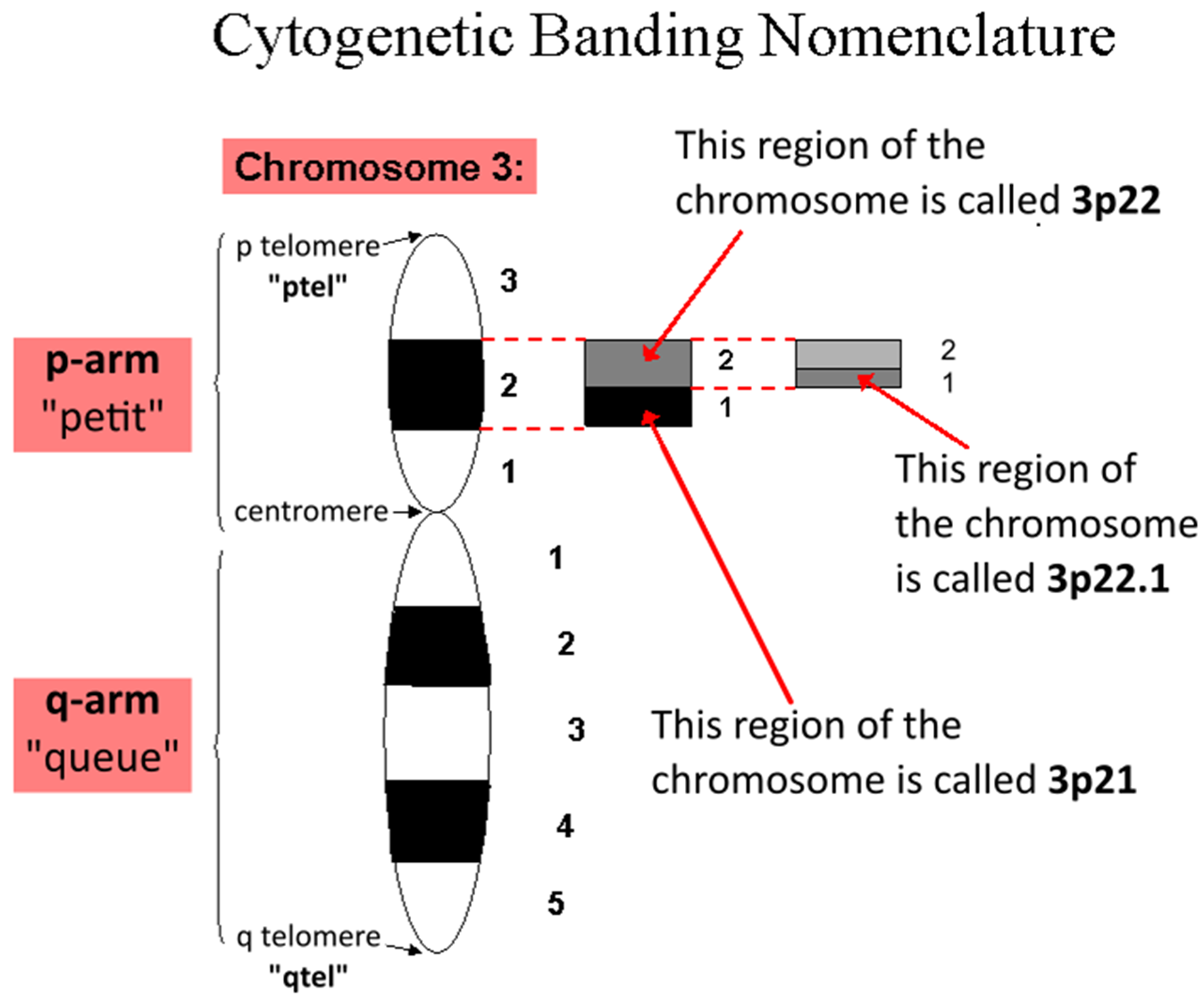FLASHCARDS Chapter 11: Human Genetic Variation (and Chapter 15.2 Chromosomal Abnormalities)
0.0(0)
0.0(0)
New
Card Sorting
1/21
Earn XP
Description and Tags
Study Analytics
Name | Mastery | Learn | Test | Matching | Spaced |
|---|
No study sessions yet.
22 Terms
1
New cards
### @@What types of sequence variation exist (single nucleotide to chromosomal level)?@@
* What is the difference between variant and mutation?
* same thing
* SNP Point mutations
* substitution
* deletion/ addition
* Copy number variation (CNV)
* polyploidy
* Aneuploidy
* Mixoploidy
* Recombination errors
* chromosome cross-over during mitosi
* Chromosomal
* Translocations
* Duplications
* Inversions
* Indels/Delins
* same thing
* SNP Point mutations
* substitution
* deletion/ addition
* Copy number variation (CNV)
* polyploidy
* Aneuploidy
* Mixoploidy
* Recombination errors
* chromosome cross-over during mitosi
* Chromosomal
* Translocations
* Duplications
* Inversions
* Indels/Delins
2
New cards
\
### @@What are the most common damages that occur to a DNA molecule as the result of endogenous sources, including chromosomal abnormalities (Ch. 15.2)?@@
### @@What are the most common damages that occur to a DNA molecule as the result of endogenous sources, including chromosomal abnormalities (Ch. 15.2)?@@
* DNA replication errors:
* replication slippage → deletion or expansion ( especially during very repetitive strands
* causes Huntington disease ( accumulation of toxic debris) → CAG repeats → Q( glutamine accumulation)
* Base damage
* reactive oxygen species(ROS) proudes during normal metabolic processes can damage DNA base
* Strand breaks
* single strand breaks
* double-strand breaks
* Chromosomal abnormalities
* Chemical damage
* **hydrolytic** most common damage to DNA → **depurination** the most common hydrolic damage of DNA
* reactive oxygen species(**ROS**)
* **Methylation**
* replication slippage → deletion or expansion ( especially during very repetitive strands
* causes Huntington disease ( accumulation of toxic debris) → CAG repeats → Q( glutamine accumulation)
* Base damage
* reactive oxygen species(ROS) proudes during normal metabolic processes can damage DNA base
* Strand breaks
* single strand breaks
* double-strand breaks
* Chromosomal abnormalities
* Chemical damage
* **hydrolytic** most common damage to DNA → **depurination** the most common hydrolic damage of DNA
* reactive oxygen species(**ROS**)
* **Methylation**
3
New cards
### @@What is aneuploidy and polyploidy (15.2)?@@
* **Polyploidy** → an extra set of chromosomes ( lethal/ not viable)
* **aneuploidy** → abnormal number of chromosomes ( a single chromosome is multiple or missing)
* example of aneuploidy where the people survive
* trisomy 21
* super male (XYY)
* chromosome 18
* **mixoploidy** → some cell have mutations that result in different number of chromosome sets → cause mosaicism (lethal)
* **aneuploidy** → abnormal number of chromosomes ( a single chromosome is multiple or missing)
* example of aneuploidy where the people survive
* trisomy 21
* super male (XYY)
* chromosome 18
* **mixoploidy** → some cell have mutations that result in different number of chromosome sets → cause mosaicism (lethal)
4
New cards
### @@What is a Robertsonian Translocation and how does it occur?@@
* Robertsonion Translocation (**centric fusion)**
* translocation in chromosomes but two parts of the chromosome that attach have two nearby centromeres. Both centromeres fuse together and don’t cause a problem during further mitosis → genetic information is not lost
* translocation in chromosomes but two parts of the chromosome that attach have two nearby centromeres. Both centromeres fuse together and don’t cause a problem during further mitosis → genetic information is not lost
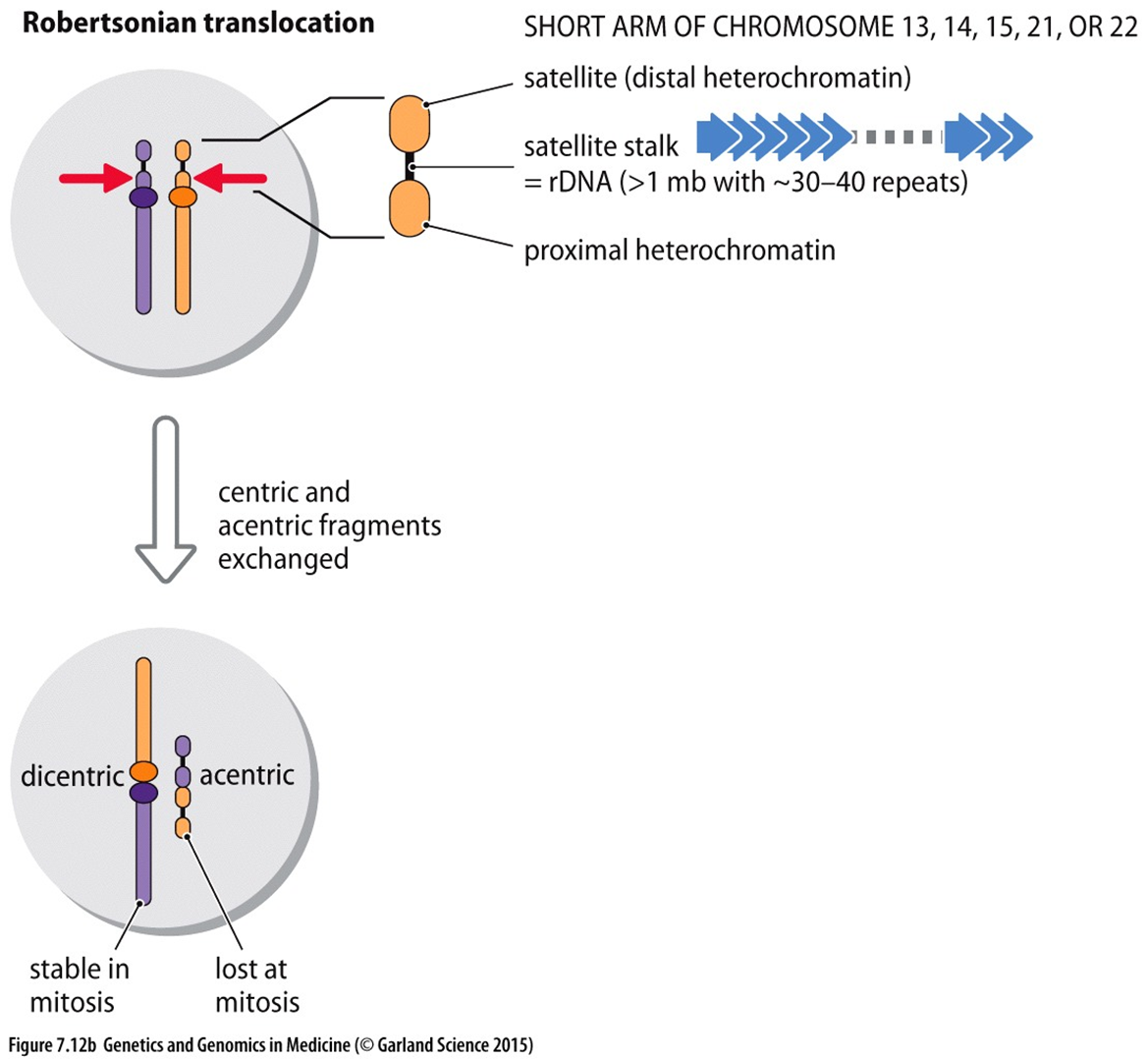
5
New cards
\
### @@What is replication slippage and why are short repetitive sequences more vulnerable to this?@@
### @@What is replication slippage and why are short repetitive sequences more vulnerable to this?@@
* occurs during DNA synthesis when the leading strand is misaligned with the leading strand template
* Polymerase can slip back wars or forward, causing an insertion or deletion
* all of this can cause egntic disorders and diseases
* Polymerase can slip back wars or forward, causing an insertion or deletion
* all of this can cause egntic disorders and diseases
6
New cards
### @@What genetic variations may result in Huntington Disease or Fragile X syndrome? Why?@@
Fragile X syndrome is a genetic disorder caused by an expansion of the CGG repeat in the FMR1 gene on the X chromosome. This results in reduced or absent production of the FMR1 protein, leading to a range of cognitive and behavioral problems. It is an X-linked dominant disorder, affecting males more severely than females because female shave another X and, therefore FMRI1 gene.

7
New cards
### @@What are the most common exogenous sources of damage? What types of damage are created?@@
* **Radiation**
* UV
* Xrays
* **chemicals**
* cigarette smoke
* nitrate and nitrate preservatives
* benzoyl peroxide
* **Infectious agents**
* HPV
* Heliobacter pylor
* UV
* Xrays
* **chemicals**
* cigarette smoke
* nitrate and nitrate preservatives
* benzoyl peroxide
* **Infectious agents**
* HPV
* Heliobacter pylor
8
New cards
### @@What are the significance of CpG islands and why are they?@@
* Cp(phosphate)G island
* CGCGCGC
* found in promoters but not actively transcribed
* when the C get methylated( which it easily done C→T) then there is no transcription
* CGCGCGC
* found in promoters but not actively transcribed
* when the C get methylated( which it easily done C→T) then there is no transcription
9
New cards
### ==What are the primary mechanisms that cells use to repair DNA damages? How does DNA polymerase “proofread”?==
* if bases are mismatched, then they don’t fit together and the following bases are also wonky
* The polymerase also notices and pauses replication and uses exonuclease activity to remove the incorrect nucleotide.
* The polymerase also notices and pauses replication and uses exonuclease activity to remove the incorrect nucleotide.
10
New cards
### ==What are the general steps in Base Excision Repair (BER), Nucleotide Excision Repair (NER), Mismatch Repair (MMR), Homologous Recombination (HR) and Non-Homologous End Joining (NHEJ)?==
\
\
Process of repairing DNA damage:
1. BER - damaged base is removed by a glycosylase enzyme and replaced with a new nucleotide.
2. NER - damaged segment is removed by an endonuclease and replaced with a new segment.
3. MMR - mismatched nucleotide is detected and removed, and the correct nucleotide is inserted.
4. HR - damaged DNA strand is repaired using a homologous template.
5. NHEJ - broken DNA ends are rejoined without a homologous template.
1. BER - damaged base is removed by a glycosylase enzyme and replaced with a new nucleotide.
2. NER - damaged segment is removed by an endonuclease and replaced with a new segment.
3. MMR - mismatched nucleotide is detected and removed, and the correct nucleotide is inserted.
4. HR - damaged DNA strand is repaired using a homologous template.
5. NHEJ - broken DNA ends are rejoined without a homologous template.
11
New cards
### ==What is translesion synthesis? When and why is it initiated?==
only used in emergencies because there is no proof reading
12
New cards
### ==What are the primary diseases/outcomes seen in individuals with defective DNA repair mechanisms?==
* cancer
* apoptosis
* apoptosis
13
New cards
### What are the varying scales of genetic variation? What is structural variation? How does balanced structural variation differ from unbalanced structural variation? What is aneuploidy?
* **balanced variation** → all of the gentic martial is still there
* NO net loss or gain
* Translocations
* Inversions
* Point mutations
* **unbalanced** → not all genetic material
* Change in copy number
* Abnormal chromosome segregation
* Point mutations
\
* **Example**: Philadephia chromosome
* when chromosome 9 and chromosome 22 break and exchange portions
* causes Leukemia
* NO net loss or gain
* Translocations
* Inversions
* Point mutations
* **unbalanced** → not all genetic material
* Change in copy number
* Abnormal chromosome segregation
* Point mutations
\
* **Example**: Philadephia chromosome
* when chromosome 9 and chromosome 22 break and exchange portions
* causes Leukemia
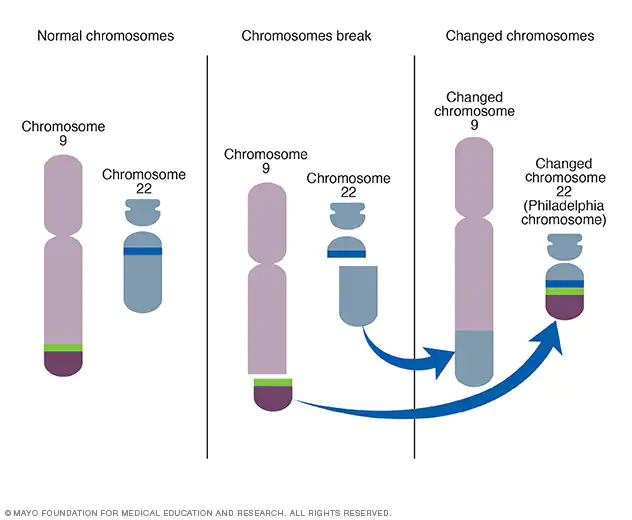
14
New cards
### What is satellite DNA? Why is replication slippage more common in arrays of tandem repeats?
* **Satellite DNA**: highly repetitive noncoding region if the genome, located near the centromeres and telomeres region of chromosome
* why is replication slippage more common?
* when the DNA polymerase enzymes slips from the DNA strand and adds or deletes on e or more repeats
* if slippage occurs pieces still fit together and polymerase is unable to detect if they made a mistake
* why is replication slippage more common?
* when the DNA polymerase enzymes slips from the DNA strand and adds or deletes on e or more repeats
* if slippage occurs pieces still fit together and polymerase is unable to detect if they made a mistake

15
New cards
### Know the similarities and differences between Single Nucleotide Variation, Single Nucleotide Polymorphisms (SNP), “indels”, Copy Number Variants (CNV), Variable Number Tandem Repeats (VNTR).
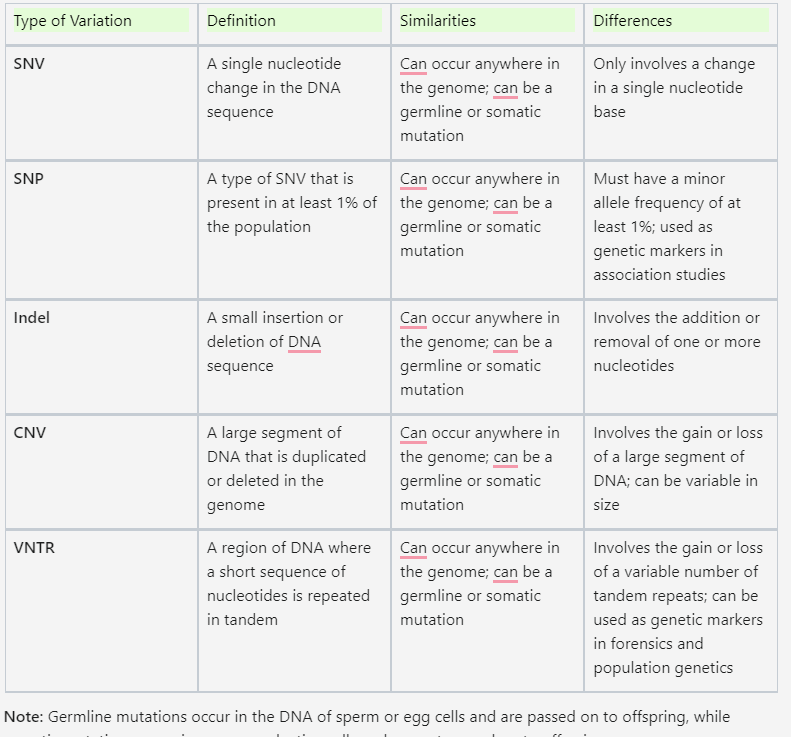
16
New cards
### What is population based genome sequencing? What is the 1000Genomes project. What is the T2T Consortium? What did they find?
### What is population based genome sequencing? What is the 1000Genomes project. What is the T2T Consortium? What did they find?
* **1000Genome project:** indicated in 2008 in 26 different population
* goal: search for de novo mutations
* found that African populations had the most variations in genome and Europe, east Asia and South Asia least variation
* → founders effect
* T**elomere to telomere consortium:** focused on identifying the first complete assembly of human genome with euchromatic and heterochromatic region8 coding and non-coding)
* **1000Genome project:** indicated in 2008 in 26 different population
* goal: search for de novo mutations
* found that African populations had the most variations in genome and Europe, east Asia and South Asia least variation
* → founders effect
* T**elomere to telomere consortium:** focused on identifying the first complete assembly of human genome with euchromatic and heterochromatic region8 coding and non-coding)
17
New cards
### What percent of our genome is thought to be under *functional constraint*? Explain why this percentage is greater than the 1.2% (the genome that is encoding for proteins). Be able to *explain* multiple reasons why. Compare this idea of functional constraint to findings by the ENCODE Consortium.
* Functional constraint: parts of DNA genome is silenced through methylation and phosphorylation
* Most protein variation have a neutral effect and not necceraly cause a a dise( example blood groups)
* Most protein variation have a neutral effect and not necceraly cause a a dise( example blood groups)
18
New cards
### What are examples of where genetic variation does indeed change the phenotype/protein(s) produced, but the effect is still neutral?
blood group
19
New cards
### *Cytogenetics: How could a Philadelphia Chromosome be detected using FISH? (not in box 15.1)*
* **Cytogenetics**: branch of genetics and biology concerned with chromosomal behavior
* **FISH**: a molecular cytogenetic technique that allows the localization of a specific DNA sequence or an entire chromosome in a cell
* for Philadelphia Chromosome: tag both chromosome with different fluorescence molecules and take multiple pictures of translocation
* **FISH**: a molecular cytogenetic technique that allows the localization of a specific DNA sequence or an entire chromosome in a cell
* for Philadelphia Chromosome: tag both chromosome with different fluorescence molecules and take multiple pictures of translocation
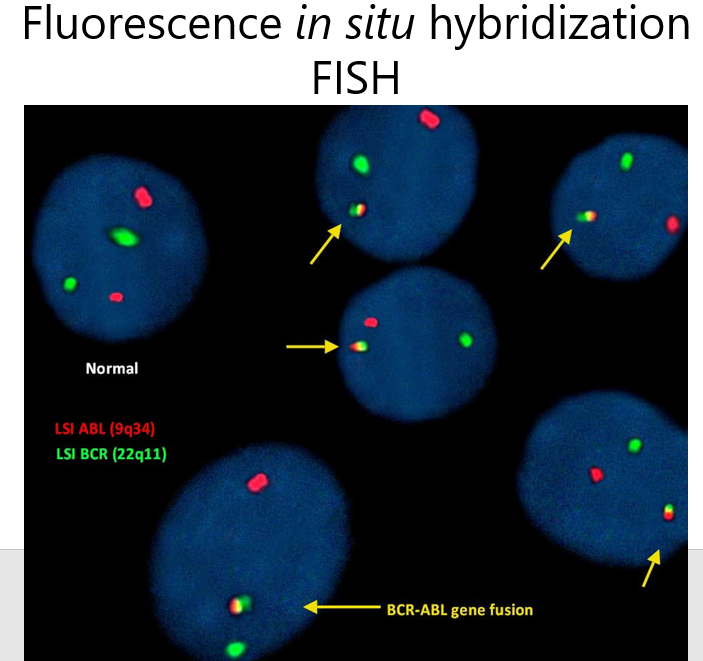
20
New cards
### What is “G-banding”? In which stage of the cell cycle are chromosomes extracted and stained (mitotic or interphase)? Which parts of the chromosome stain darker and lighter?
* G-banding: A type of standing with Giemsa stain
* DNA from white blood cells during prometaphase ( as condenst)
* dark color= AT-rich → gene poor
* light color= GC rich → gene-rich
* DNA from white blood cells during prometaphase ( as condenst)
* dark color= AT-rich → gene poor
* light color= GC rich → gene-rich
21
New cards
\
### What are the names of the two arms of a chromosome?
### What are the names of the two arms of a chromosome?
p= petit and q= queue
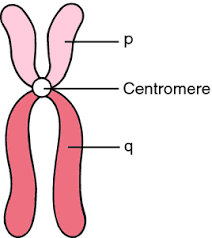
22
New cards
### What does it mean to be Metacentric, Submetacentric, Acrocentric or for a chromosome to be acentric?
position of centromere
* **Metacentric** (center)
* **Submetacentric** (between middle and telomere)
* **Acrocentric** (near telomere)
* **Metacentric** (center)
* **Submetacentric** (between middle and telomere)
* **Acrocentric** (near telomere)
